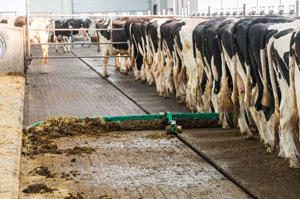
Manage your alley scraper system to help ensure your cows are safe and clean with these tips:
Scraper system
- Check your control panel load sensor seasonally to monitor the scraper system’s power. Monitoring its power will limit the chance of creating extremely high cable tension and help you notice abnormal power spikes.
- Manage the control panel settings for proper sensitivity, especially during dry conditions or when you bed stalls.
- Properly adjust the tension of your scraper cable, rope or chain system to prevent scrapers from jumping around and potentially pinching a tail against the curb. Your local equipment dealer can assist you with this task if needed, or check the manual for detailed instructions.
- Leave 1 inch between your scraper wing and the curb to help prevent pinching tails.
- Consider having a scraper wing with a roller for offset alleys or if you want to keep the blade tip touching the curb.
- Choose a blade that has smooth surfaces near the stall beds as they make it more difficult to snag a loose strand of hair.
- Take care of sharp edges, protruding bolts or pinch points immediately to reduce injury to your cows.
Freestall
- Be sure your brisket board is in its proper position for your herd (typically 65–72 inches ahead of the rear curb) to allow cows to move ahead in the stall. This adjustment will allow cows to have more of their body in the stall. Note: It may require more frequent cleaning of the stall bed as the chance of manure in the rear third of the stall may increase.
- Maintain a fly abatement program and ensure proper airflow to reduce the presence of flies. This reduces the likelihood of a cow to swing her tail and leave it in the alley.
- Adjust scraper run times to align with milking, feeding or pushing up feed to reduce the chance of a cow lying in the stall at scraping times.
- Alter feeding pattern to align with the scraper position in pens.
Other management considerations include having safety glasses for your employees to prevent tail switches from harming their eyes during milking. Having a tail trimming protocol that works for your dairy’s schedule is also beneficial. For example, you may consider trimming every cow’s tail when she calves.
“A clean environment is key for high-milk quality,” says Lenkaitis. “By taking care of your automated barn scraper system, you will take care of your cows and your cows will take care of you.”
If you have questions about your automated barn scraper system or are considering one for your barn, contact your local GEA manure equipment representative.
About GEA
GEA is one of the largest suppliers of process technology for the food industry and a wide range of other industries. The international technology group focuses on process technology and components for sophisticated production processes in various end-user markets.
In 2017, GEA generated consolidated revenues of about EUR 4.6 billion. The food and beverages sector, which is a long-term growth industry, accounted for around 70 percent. The company employs almost 18,000 people worldwide. GEA is a market and technology leader in its business areas. The company is listed on the German MDAX stock index (G1A, WKN 660 200) and included in the STOXX® Europe 600 Index. In addition, the company is listed in selected MSCI Global Sustainability Indexes. Further information is available at gea.com.


